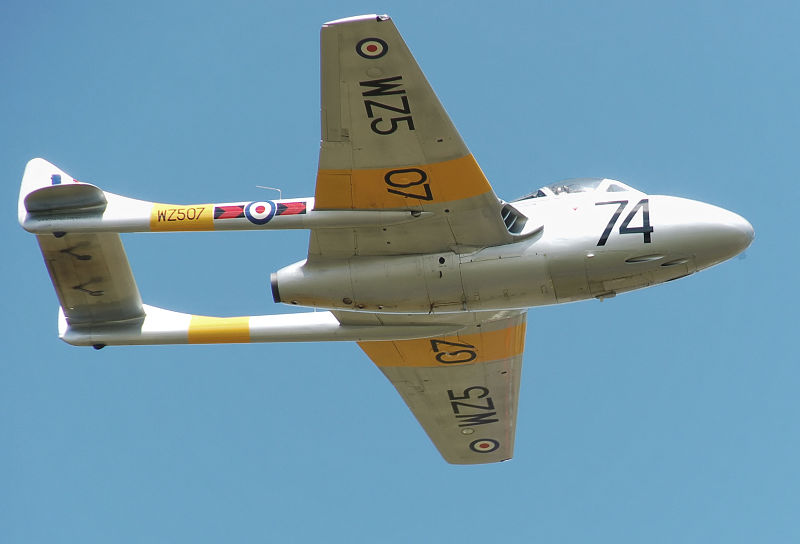Ystradgynlais Aircraft Crash Site
3) Vampire VZ106
Crashed 9th October 1953
The Vampire aircraft, with the designation VZ106, crashed in the Brecon Beacons on 9th October 1953. The table below explains the circumstances and location of the crash, as well as access details and a generic photograph of this kind of aircraft.
Return to the Brecon Beacons Aircraft Crash Index.
The South Wales Voice newspaper of Friday 23rd October 1953 recorded the events as they unfolded:
MYSTERY OF BLACK MOUNTAIN
by Llew T Jones
Once again the mist-enshrouded slopes of Black Mountain have claimed another flyer as victim.
Last week as the tired search party clambered wearily down the mountainside, bearing the dead body of Pilot Officer J.R.B. Baldock (pilot of the Vampire jet which had been missing for a week) I heard two local people talking quietly to each other of the hoodoo which seems to lurk in this area wher there have been FIVE crashes since 1939.
Of course, no sensible person believes those who shake their heads and talk of "some strange magnetic force pulling the planes down from the sky like some giant hand..."
But it is a cold hard fact, nevertheless, that wreckage of crashed planes have straddled these inhospitable slopes on five different occasions.
As I stood on Thursday night and watched eerie flares lighting the rescuers way down the mountainside, mymind went back to a similar scene I had witnessed over fourteen years ago, when miners from the Valley went out in force to search for a training Anson that had crashed in the fog.
On that occasion I was one of the search party and with our stretcher we were once within 200 yards of the crashed plane - but because of the fog which kept visibility down to six yards, we did not see it.
The pilot, a fine young man, died of exposure, and it was this fact which prompted me to write to the authorities at that time suggesting that all RAF pilots should be issued with whistles, so that they could draw attention to themselves and thus aid search parties. I have still, in my possession, the letter of acknowledgement telling me that my suggestion would be passed to the proper quarters, and I like to think that the fact that today all RAF men carry whistles as part of their equipment is partly due to my initiative.
But to return to last week's tragic crash. The pilot in this case was killed instantly so there was no question of saving him.
Like everyone in the locality, I knew a plane was missing and wanted to do everything in my power to help locate it. (In 1939, incidentally, the authorities were so grateful for the help of miners and other local residents during the search, that they gave £100 to the locality to build two ambulance kiosks.)
About four o'clock on Thursday afternoon last, I was going with a friend up to Pen-y-Cae and I suggested that as we were in the locality we should go on over to the Gwyn Arms.
Here we saw an RAF man who said that he thought the crashed plane had been located. He pin-pointed it on a large-scale map for me,and I told him that in my opinion it was not far from where the Anson had crashed in 1939.
My guess was subsequently confirmed. As we talked, further messages were coming in by wireless from the search party and a Wellington was flying backwards and forwards over New Llyn-y-Fan Fawr.
No authentic news had been received, however, so I returned home.
At around seven o'clock, I returned by car to the Gwyn Arms and was told by an RAF man that there was an officer a couple of miles further up the road. I went along the old Trecastle Road.
About three miles along the road, opposite Llyn-y-fan Fawr, we met RAF lorries coming back. The officer in charge told me that the mountain rescue squad were coming down the mountainside with the body of Pilot Office Baldock.
The wreck had been discovered by a farmer, Islwyn Jones, of Tir Capel Farm, Trecastle, while he was attending his sheep near the Van Lake, Black Mountain.
It was about a mile away from where the Anson had crashed in 1939, and not far from where a Wellington bomber had come down in 1944.
As I stood by the Gwyn Arms at about 7:30 that night and watched the weary search party return with their pitiful load, I thought once again of Black Mountain and its apparently fatal attraction to flyers.
...
WITH FIVE CRASHES ALREADY LITTERING ITS SLOPES, I FEEL IT IS TIME THAT THE RAF INSTRUCTED ITS PILOTS TO FLY CLEAR OF TREACHEROUS BLACK MOUNTAIN.
The training Anson L9149 crashed on 17th January 1939. A fuller account of the story about the whistle can be found in our article Uncle Llew's Whistle, the Uncle Llew being of course the author of the newspaper article quoted above.
The Wellington bomber mentioned later in the article by Llew Jones is Wellington MF509 which crashed on 20th November 1944, which had a Canadian crew.


